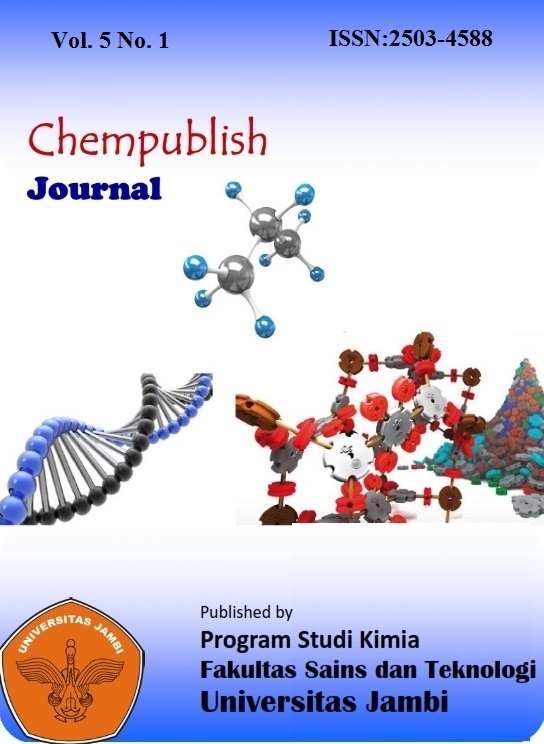Pengolahan limbah cair tahu menjadi air bersih dengan metode elektrokoagulasi secara kontinyu
DOI:
https://doi.org/10.22437/chp.v5i1.7651Kata Kunci:
Tofu liquid waste, electrocoagulation,voltage, flow rateAbstrak
The liquid waste of the tofu industry contains high organic contaminants, such as proteins and amino acids. These organic compounds causes liquid waste of tofu industry to contain high BOD, COD, and TSS so that it can pollute the environment. Therefore, tofu liquid should be removed first by electrocoagulation method. This method has the potential to purify tofu liquid waste and decrease the content of COD, BOD, TSS, and pH contained without the addition of coagulants. The purpose of this study was to determine the effect of voltage and flow rate to neutralize pH, and reduce levels of COD, BOD, and TSS in tofu liquid waste. The parameters tested included COD, BOD, TSS, and pH. The electrocoagulation process uses electrical power that flows in the direction of the electrode. The electrocoagulation reactor was paired with a cable connected to the power supply then connected to an electric current with voltage and flow rate variations. The results of this study found that optimum conditions were obtained at current of 12 V and flow rate of 0.087 L/min with increasing pH from pH from 3.5 to 6.7, percent removal of COD 72.17%, percent removal BOD 71.53% , and percent removal TSS 90.90%.
Unduhan
Referensi
Hudori dan Soewondo, P. 2009. Pengolahan deterjen Menggunakan Teknologi Elektrokoagulasi dengan Elektroda Aluminium. Bandung. Jurnal Sains dan Teknologi Lingkungan. 1 (2): 117-125.
Iswanto, B., Silalahi, M. DS., dan Purnama, F. D. 2009. Pengolahan Air Limbah Emulsi Minyak-Deterjen dengan Proses Elektrokoagulasi menggunakan Elektroda Aluminium. Jakarta. JTL. 5 (2): 55-61.
Kamilul. 2008. Kelebihan dan Kekurangan Metode Elektrokoagulasi. Skripsi Program Studi Kimia Jurusan Pendidikan Kimia FPMIPA UPI. Bandung.
Kementrian Lingkungan Hidup. 2014. Peraturan Menteri Lingkungan Hidup Republik Indonesia Nomor 5 Tahun 2014 Tentang Baku Mutu Air Limbah. Jakarta: KLH.
Liu, H., Zhao, X., dan Qu, J. 2010. Electrochemistry for the Environment. C. Comninellis dan G. Chen, Eds.
Ni’am, A. C., Caroline, J., dan Afandi, M. H. 2017. Variasi Jumlah Elektroda dan Besar Tegangan dalam Menurunkan Kandungan COD dan TSS Limbah Cair Tekstil dengan Metode Elektrokoagulasi. Jurnal Teknik Lingkungan. Institut Teknologi Adhi Tama Surabaya. 3 (1): 21-26
Nohong. 2010. Pemanfaatan Limbah Tahu Sebagai Bahan Penyerap Logam Krom, Kadmium dan Besi dalam Air Lindi TPA. Jurnal Pembelajaran Sains. 6 (2): 257 – 269.
Ratnani, R. D. 2012. Kemampuan Kombinasi Eceng Gondok dan Lumpur Aktif Untuk Menurunkan Pencemaran Pada Limbah Cair Industri Tahu. Momentum. 8 (1): 1–5.
Setianingrum, N. P., Prasetyo, A., Sarto. 2016. Pengaruh Tegangan dan Jarak Antar Elektroda Terhadap Pewarna Remazol Red Rb dengan Metode Elektrokoagulasi. Inovasi Teknik Kimia.1 (2): 93-97
Yolanda G.M. 2015. Pengolahan Limbah Cair Laboratorium dengan Proses Elektrokoagulasi. Skripsi. Departemen Teknologi Industri Pertanian. Fakultas Teknologi Pertanian Bogor.
Yulianto, A., Luqman H., Indah P., Vidya Ayu P. 2009. Pengolahan Limbah Cair Industri Batik Pada Skala Laboratorium dengan Menggunakan Metode Elektrokoagulasi. Jurnal Teknologi Lingkungan.
##submission.downloads##
Diterbitkan
Versi
- 2020-05-31 (1)
- 2020-05-31 (1)





